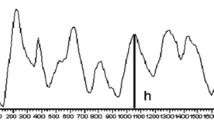Abstract
Atomic force microscopy is applied to measure intermolecular forces and mechanical properties of materials, nano-particle manipulation, surface scanning and imaging with atomic accuracy in the nano-world. During nano-manipulation process, contact forces cause indentation in contact area between nano-particle and tip/substrate which is considerable at nano-scale and affects the nano-manipulation process. Several nano-contact mechanics models such as Hertz, Derjaguin–Muller–Toporov (DMT), Johnson–Kendall–Roberts–Sperling (JKRS), Burnham–Colton–Pollock (BCP), Maugis–Dugdale (MD), Carpick–Ogletree–Salmeron (COS), Pietrement–Troyon (PT), and Sun et al. have been applied as the continuum mechanics approaches at nano-scale. In this article, indentation depth and contact radius between tip and substrate with nano-particle for both spherical and conical tip shape during nano-manipulation process are analyzed and compared by applying theoretical, semiempirical, and empirical nano-contact mechanics models. The effects of adhesion force, as the main contrast point in different nano-contact mechanics models, on nano-manipulation analysis is investigated for different contact radius, and the critical point is discussed for mentioned models.


















Similar content being viewed by others
Abbreviations
- a :
-
Spherical contact-radius
- a0(α):
-
Contact-radius at zero applied force
- b :
-
Cylindrical contact-radius
- E :
-
Young’s moduli
- E p :
-
Nano-particle Young’s moduli
- E*:
-
Elastic constant
- F :
-
Applied load
- F ad :
-
Adhesion force
- F s :
-
Particle–substrate force in contact area
- F T :
-
Pushing force
- F t :
-
Tip–particle force in contact area
- F Y :
-
Lateral tip force
- F y :
-
Bending force of the cantilever
- F Z :
-
Normal tip force
- F z :
-
Bending force of the cantilever
- G :
-
Shear modulus
- H :
-
Probe height
- I p :
-
Moment of inertia
- K :
-
Elastic modulus
- K y :
-
Lateral spring constant of the cantilever
- K z :
-
Normal spring constant of the cantilever
- K θ :
-
Torsional spring constant of the cantilever
- L :
-
Length of the cantilever
- M θ :
-
Torsional torque of the cantilever
- m :
-
The ratio of the width of the annular region c to a
- \( \tilde{R} \) :
-
Effective radius of two contacted surfaces
- R p :
-
Nano-particle radius
- R t :
-
Spherical tip radius
- t :
-
Thickness of the cantilever
- V :
-
Shear force
- w :
-
Width of the cantilever
- y p :
-
Horizontal deflection of the probe
- y s :
-
Horizontal displacement of substrate
- y T :
-
Horizontal displacement of tip
- z p :
-
Vertical deflection of the probe
- z s :
-
Vertical displacement of substrate
- z T :
-
Vertical displacement of tip
- α :
-
Dimensionless parameter dependent on λ
- δ :
-
Indentation depth
- δ s :
-
Indentation depth between nano-particle and substrate
- δ t :
-
Indentation depth between tip and nano-particle
- \( \phi \) :
-
Angle of tip–particle contact
- \( \varphi \) :
-
Half angle of conical tip
- γ t :
-
Tip surface energy
- γ p :
-
Nano-particle surface energy
- γ tp :
-
Tip–particle interface surface energy
- λ :
-
Tabor dimensionless parameter
- θ :
-
Twist angle of the probe
- σ :
-
Molecular diameter
- ρ :
-
Density
- υ :
-
Poison’s coefficients
- ω :
-
Adhesion energy
- Ψ :
-
Pushing force angle
- ∆γ:
-
Work of adhesion force
References
Bhushan B (2005) Nanotribology and nanomechanics, an introduction. Springer, Berlin, pp 419–590
Binnig G, Quate CF, Gerber C (1986) Atomic force microscope. Phys Rev Lett 56:930–933
Binning G, Rohrer H (2000) Scanning tunneling microscopy. IBM J Res Develop 44:279–293
Burnham NA, Kulik AJ (1999) Surface forces and adhesion. In: Bhushan B (ed) Handbook of micro/nanotribology, Chap. 5. CRC Press LLC, Boca Raton
Carpick RW, Ogletree DF, Salmeron M (1999) A general equation for fitting contact area and friction vs load measurements. J Colloid Interface Sci 211:395–400
Fatikow S (2008) Automated nanohandling by microrobots. Springer, Heidelberg, pp 1–8
Israelachvili J (1992) Intermolecular and surface forces. Academic Press, London, pp 316–327
Johnson KL (1985) Contact mechanics. Cambridge University, London, pp 84–106
Johnson K, Greenwood J (1997) An adhesion map for the contact of elastic spheres. J Colloid Interface Sci 192:326–333
Pietrement O, Troyon M (2000) General equations describing elastic indentation depth and normal contact stiffness versus load. J Colloid Interface Sci 226:166–171
Requicha AAG (1999) Nanorobotics. In: Nof S (ed) Handbook of industrial robotics. Wiley, New York, pp 199–210
Shi X, Zhao YP (2004) Comparison of various adhesion contact theories and the influence of dimensionless load parameter. J Adhesion Sci Technol 18:55–68
Sitti M, Hashimoto H (2003) Teleoperated touch feedback from the surfaces at the nanoscale: modelling and experiments. IEEE/ASME Trans Mechatron 8:287–298
Stroscio JA, Eigler DM (1991) Atomic and molecular manipulation with the scanning tunneling microscope. Science 254:1319–1326
Sun Y, Akhremitchev B, Walker GC (2004) Using the adhesive interaction between atomic force microscopy tips and polymer surfaces to measure the elastic modulus of compliant samples. Langmuir 20:5837–5845
Tafazzoli A, Sitti M (2004) Dynamic behavior and simulation of nanoparticle sliding during nanoprobe-based positioning. In: ASME proceedings of International conference on mechanical engineering congress, pp 965–972
Author information
Authors and Affiliations
Corresponding author
Rights and permissions
About this article
Cite this article
Daeinabi, K., Korayem, M.H. Indentation analysis of nano-particle using nano-contact mechanics models during nano-manipulation based on atomic force microscopy. J Nanopart Res 13, 1075–1091 (2011). https://doi.org/10.1007/s11051-010-0096-y
Received:
Accepted:
Published:
Issue Date:
DOI: https://doi.org/10.1007/s11051-010-0096-y




